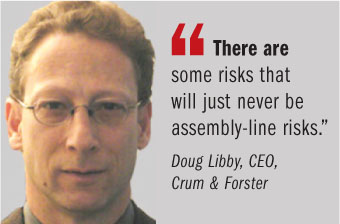For the CEO of Crum & Forster, Doug Libby, who voluntarilydescribes himself as “a contrarian,” there is little not to likeabout the $294 million deal, closed in February, that adds FirstMercury Financial Corp. to his group's specialty-insuranceoperations.
|Libby believes First Mercury's excess-and-surplus linesbusinesses gel perfectly with the “out-of-the-box” thinking andunderwriting culture that he has ingrained in C&F'sadmitted-specialty operations for over a decade.
| The former lawyer, who onceworked as general counsel for an investment-banking firm, draws aparallel to the arbitrage departments of Wall Street firms as hedescribes his approach to the insurance business—a strategy he hasfollowed since becoming CEO of Seneca Insurance (now a subsidiaryof C&F) in 1989.
The former lawyer, who onceworked as general counsel for an investment-banking firm, draws aparallel to the arbitrage departments of Wall Street firms as hedescribes his approach to the insurance business—a strategy he hasfollowed since becoming CEO of Seneca Insurance (now a subsidiaryof C&F) in 1989.
Wall Street firms “look at the values of certain types ofsecurities, try to figure out what they're really worth, and thenset up certain kinds of arbitrage.” In the same way, a specialtyinsurer can ask, “Where does the market have it wrong?” focusing onoutlier risks that commercial-insurance-class plans don't captureappropriately, Libby says.
|He gives the example of the auto-repair class for workers'compensation in California, assuming it carries a fictitious rateof $2.50 per unit of payroll for the sake of discussion. “You canwrite a luxury car dealership that is worth a 50-cent rate. Or youcan write a truck-repair facility that has an enormous tow truck topick up buses on the side of the road”—a risk that might reasonablycommand a rate that is much higher than the class rate.
|“The system works in such a way that there are oftenopportunities at both ends,” Libby says. “If you really think aboutunderwriting and get to know industries well, there's opportunityto make more money.”
|That's what newly acquired First Mercury has done for nearly 40years—developing expertise in writing liability insurance forsecurity guards, detectives, alarm installers, safety equipment,and distributing its insurance products under the CoverX brand.
|C&F is taking a page out of CoverX's playbook as it expandsits writings in workers' comp for elevator-maintenance contractorsin New York City, according to Libby, who contrasts the approach ofa thoughtful niche underwriter and a typical carrier.
|Instead of just consulting industry-class manuals forunderwriting and loss-control guidelines, “I sent out a team ofloss-control, claims and underwriting [professionals] who met witha number of elevator-maintenance contractors in the Bronx,” Libbysays. “The elevators don't get tougher” than in that borough, hesays, noting that some are more than 100 years old, with concurrentmaintenance problems that occur with age.
|“I have always been interested in thinking outside the box [inan] industry [that] is all about boxes,” he says.
|“At Seneca, our approach was always to focus on lines whereunderwriting judgment and experience make a difference,” he says,adding that the strategy is equally applicable to E&S andspecialty-admitted business, highlighting expertise that Senecadeveloped writing vacant buildings.
|In general, the insurance industry has expended tremendouseffort to move toward an assembly-line method of risk assessment.“We're trying to go the other way. There are some risks that willjust never be assembly-line risks,” he says.
|Before January 2008, when Libby took the CEO spot at C&F, hesays the mix of business was tilted toward standard lines, whichmade up roughly 70 percent of the C&F book. Now it'sapproximately 70 percent specialty, he reports, noting that thefigure could increase in future years—after the First Mercury dealis fully digested.
|In addition to security-specialist CoverX and related insurersFirst Mercury Insurance Co. and First Mercury Casualty Co., C&Falso picked up as part of the deal American Management Corp. (AMC),a specialist in insurance for fuel-related businesses includingservice stations, repair garages and fuel-oil jobbers.
|AMC's business is very closely related to the energy businesswritten by C&F's Fairmont Specialty, Libby says, highlighting aFairmont niche: propane-gas distributors.
|Libby sat down with NU for an exclusive interview inearly June, two days after C&F announced a rebrandinginitiative that will put most of First Mercury's $300 million bookof E&S casualty business (minus some small MGA programs)together with existing C&F, Seneca and Valiant InsuranceE&S business under a new banner—CoverXSpecialty—and under thedirection of Richard Smith, chair and CEO of First Mercury.
|C&F also announced that AMC and Fairmont Specialtyenergy-related businesses will have a combined book of over $150million in gross premiums.
Want to continue reading?
Become a Free PropertyCasualty360 Digital Reader
Your access to unlimited PropertyCasualty360 content isn’t changing.
Once you are an ALM digital member, you’ll receive:
- All PropertyCasualty360.com news coverage, best practices, and in-depth analysis.
- Educational webcasts, resources from industry leaders, and informative newsletters.
- Other award-winning websites including BenefitsPRO.com and ThinkAdvisor.com.
Already have an account? Sign In
© 2024 ALM Global, LLC, All Rights Reserved. Request academic re-use from www.copyright.com. All other uses, submit a request to [email protected]. For more information visit Asset & Logo Licensing.








